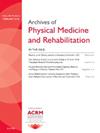Association of Calf Circumference, Hand Grip Strength, and Physical Performance With Serious Adverse Events in Individuals With Subacute Stroke Hospitalized for Rehabilitation: An Observational Study
IF 3.6
2区 医学
Q1 REHABILITATION
Archives of physical medicine and rehabilitation
Pub Date : 2025-03-01
DOI:10.1016/j.apmr.2024.09.015
引用次数: 0
Abstract
Objective
To determine whether calf circumference, hand grip strength, and physical performance are linked to the incidence of serious adverse events (SAEs) in patients with subacute stroke.
Design
Retrospective cohort study.
Setting
Single rehabilitation hospital.
Participants
Patients with stroke admitted for rehabilitation hospital.
Intervention
Not applicable.
Main Outcome Measures
The incidence of SAEs, such as death, cardiovascular events including recurrent stroke, and conditions requiring transfer to another hospital for specialized care or immediate treatment for an acute illness during hospitalization.
Results
A total of 341 patients (median age: 74y) participated in this study, with 232 patients (68%) exhibiting low-physical performance. In the adjusted model, low-physical performance was significantly associated with SAEs (hazard ratio [HR], 3.01; 95% confidence interval [CI], 1.04-8.68; P=.042). However, low calf circumference (HR, 1.60; 95% CI, 0.76-3.38; P=.219) and low hand grip strength (HR, 0.98; 95% CI, 0.39-2.42; P=.960) did not show an independent association.
Conclusions
Low-physical performance was independently associated with the occurrence of SAEs during hospitalization for rehabilitation in patients with subacute stroke.
住院康复的亚急性脑卒中患者的小腿围、手握力和体能表现与严重不良事件的关系:一项观察性研究
目的确定小腿围(CC)、手握力(HGS)和体能表现是否与亚急性脑卒中患者严重不良事件(SAE)的发生率有关:设计:回顾性队列研究:参与者:康复医院收治的脑卒中患者干预措施:不适用:主要结果测量主要结果测量:SAE 的发生率,如死亡、心血管事件(包括复发性卒中)、需要转院接受专业治疗或住院期间因急性病需要立即治疗的情况:共有 341 名患者(中位年龄:74 岁)参与了此次研究,其中 232 名患者(68%)体能表现较差。在调整模型中,体能低下与 SAEs 显著相关(HR = 3.01,95% CI = 1.04-8.68,p = 0.042)。然而,低 CC(HR = 1.60,95% CI = 0.76-3.38,p = 0.219)和低 HGS(HR = 0.98,95% CI = 0.39-2.42,p = 0.960)并未显示出独立的关联性:结论:体能低下与亚急性卒中患者住院康复期间发生 SAEs 有独立关联。
本文章由计算机程序翻译,如有差异,请以英文原文为准。
求助全文
约1分钟内获得全文
求助全文
来源期刊
CiteScore
6.20
自引率
4.70%
发文量
495
审稿时长
38 days
期刊介绍:
The Archives of Physical Medicine and Rehabilitation publishes original, peer-reviewed research and clinical reports on important trends and developments in physical medicine and rehabilitation and related fields. This international journal brings researchers and clinicians authoritative information on the therapeutic utilization of physical, behavioral and pharmaceutical agents in providing comprehensive care for individuals with chronic illness and disabilities.
Archives began publication in 1920, publishes monthly, and is the official journal of the American Congress of Rehabilitation Medicine. Its papers are cited more often than any other rehabilitation journal.

 求助内容:
求助内容: 应助结果提醒方式:
应助结果提醒方式:


